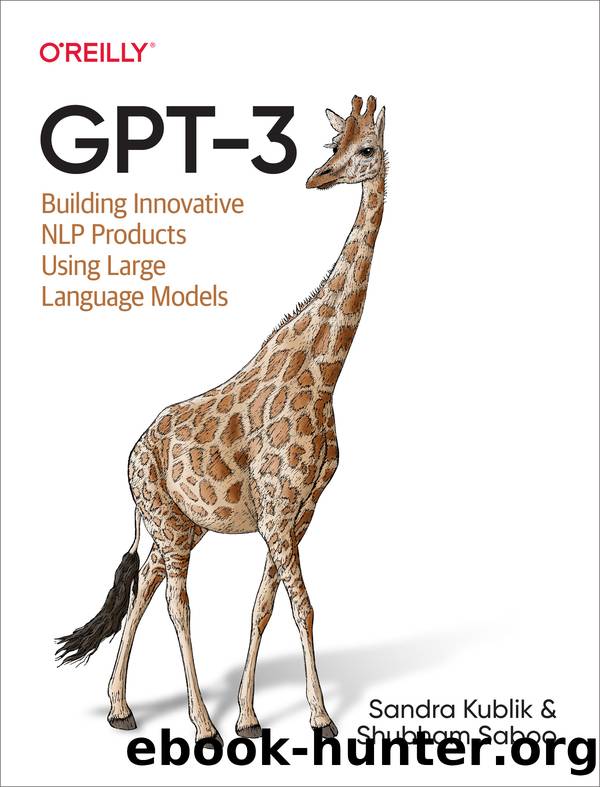GPT-3 by Sandra Kublik & Shubham Saboo

Author:Sandra Kublik & Shubham Saboo [Sandra Kublik]
Language: eng
Format: epub
Publisher: O'Reilly Media, Inc.
Published: 2022-07-14T16:00:00+00:00
Data Analysis Applications of GPT-3: Viable
The story of the start-up Viable is an example of how much things can change from the moment you start working on a business idea to actually finding a product-market fit and a customer base. Viable helps companies better understand their customers by using GPT-3 to summarize customer feedback.
Viable aggregates feedback such as surveys, help desk tickets, live chat logs, and customer reviews. It then identifies themes, emotions, and sentiments, pulls insights from those results, and provides a summary in a matter of seconds. For example, if asked, âWhatâs frustrating our customers about the checkout experience?â Viable might respond: âCustomers are frustrated with the checkout flow because it takes too long to load. They also want a way to edit their address in checkout and save multiple payment methods.â
Viableâs original business model involved helping early-stage start-up companies find product-market fit using surveys and product roadmaps. Requests started coming in from bigger companies, asking for support in analyzing huge volumes of text, such as âsupport tickets, social media, app store reviews, and survey responsesâ that changed everything, says Daniel Erickson. Erickson is the founder and CEO of Viableâand an early adopter of the OpenAI API. He explains, âI spent actually about a month just experimenting, literally just taking our data, putting it into the Playground, figuring out different prompts and things like that. And eventually, I came to the conclusion that [GPT-3] could power a very powerful question and answer system.â
Erickson and his colleagues began using the OpenAI API to interact with and generate insights from the large datasets they were working with. They initially used another NLP model, achieving mediocre results, but when they began working with GPT-3, the team saw âat least a 10% increase across the board. When weâre talking about going from 80% to 90%, thatâs a hell of an increase for us.â
Building on that success, they used GPT-3 in combination with other models and systems to create a Q&A feature that allows users to ask a question in plain English and get an answer. Viable converts the question to a complex query that can pull all the relevant feedback from the database. It then runs the data through another series of summarization and analysis models to generate a refined answer.
In addition, Viableâs system provides customers with âa 12-paragraph summary every weekâ¦that outlines things like their top complaints, their top compliments, their top requests, and top questions.â As you might expect from customer-feedback specialists, Viable has thumbs up and thumbs down buttons next to every answer the software generates. They use this feedback in retraining the model.
Humans are part of the process, too: Viable has an annotation team whose members are responsible for building training datasets, both for internal models and GPT-3 fine-tuning. They use the current iteration of that fine-tuned model to generate output, which humans then assess for quality. If the output doesnât make sense or isnât accurate, they rewrite it. And once they have a list of outputs they are satisfied with, they feed that list back into the next iteration of the training dataset.
Download
This site does not store any files on its server. We only index and link to content provided by other sites. Please contact the content providers to delete copyright contents if any and email us, we'll remove relevant links or contents immediately.
| Access | Data Mining |
| Data Modeling & Design | Data Processing |
| Data Warehousing | MySQL |
| Oracle | Other Databases |
| Relational Databases | SQL |
Algorithms of the Intelligent Web by Haralambos Marmanis;Dmitry Babenko(9832)
Azure Data and AI Architect Handbook by Olivier Mertens & Breght Van Baelen(7607)
Building Statistical Models in Python by Huy Hoang Nguyen & Paul N Adams & Stuart J Miller(7591)
Serverless Machine Learning with Amazon Redshift ML by Debu Panda & Phil Bates & Bhanu Pittampally & Sumeet Joshi(7476)
Data Wrangling on AWS by Navnit Shukla | Sankar M | Sam Palani(7234)
Driving Data Quality with Data Contracts by Andrew Jones(7229)
Machine Learning Model Serving Patterns and Best Practices by Md Johirul Islam(6962)
Learning SQL by Alan Beaulieu(6209)
Weapons of Math Destruction by Cathy O'Neil(6142)
Big Data Analysis with Python by Ivan Marin(5883)
Data Engineering with dbt by Roberto Zagni(4896)
Solidity Programming Essentials by Ritesh Modi(4528)
Time Series Analysis with Python Cookbook by Tarek A. Atwan(4356)
Pandas Cookbook by Theodore Petrou(4057)
Blockchain Basics by Daniel Drescher(3507)
Natural Language Processing with Java Cookbook by Richard M. Reese(3099)
Hands-On Machine Learning for Algorithmic Trading by Stefan Jansen(3027)
Feature Store for Machine Learning by Jayanth Kumar M J(2908)
Learn T-SQL Querying by Pam Lahoud & Pedro Lopes(2878)
